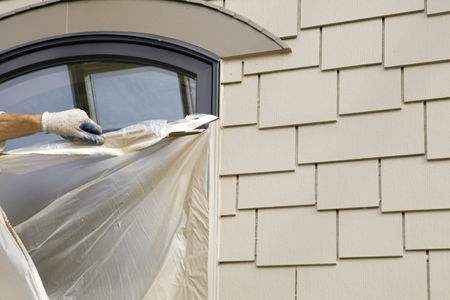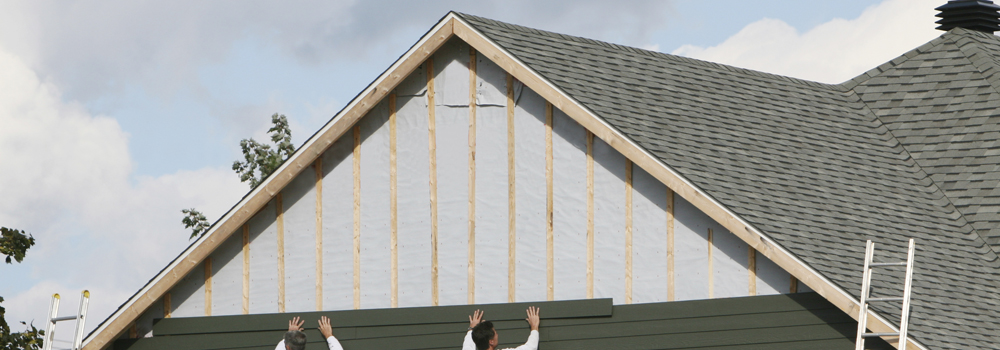Home builders are leaning more and more toward using eco-friendly materials when constructing new homes. But you don’t have to buy or build new in order to have a green home. Replacing your home’s current siding with a more environmentally friendly option is one of the best ways to reduce your carbon footprint. Not only will a more sustainable siding option increase your home’s efficiency, it will limit the emissions created in the production and installation of the product. There are several options to choose from as far as materials. But before you decide on which one to choose, it’s helpful to know why they are considered green:
What Makes a Siding Material Eco-Friendly?
Combination of Product Materials
The best option for green building are often manufactured materials such as fiber-cement which is made up of a combination of renewable materials, including wood, sand, and water. As you evaluate your siding options, you’ll want to be sure your choice will be naturally sourced, non-toxic, and/or recycled. For instance, vinyl is not biodegradable, and it may be difficult to find a facility that will recycle it. However, natural stone or brick, while nonrenewable, can still be sustainably sourced.
Durability and Maintenance
A durable product requires little to no maintenance and will not need to be replaced as often as other products, thus minimizing both cost and environmental impact. For example, wood siding must be refinished every two to five years. However, a manufactured material like fiber-cement is designed to last a long time, even when exposed to fluctuating outdoor elements.
Reused or Recycled Material
Deciding a material’s prospective reuse or recycling ability is partly the job of the product manufacturer and partly the job of the building contractor. Some materials like wood, which will readily break down in a landfill, are more easily reusable than others. On the contrary, vinyl requires a specialized recycling process. Materials like fiber-cement require little post-consumer recycling because the product is durable and made to last. Scrap metal, paint, wood, and other materials can be donated for a local cause.
Volatile Organic Compound Emission
Volatile organic compounds (VOCs) are chemicals used in the manufacturing and maintenance of certain building materials. The chemical makeup of these could pose serious health risks, including respiratory distress, allergic reactions, nausea, and more especially in indoor environments like hospitals and schools. An example of this would be wood siding. While it is a great natural choice, it requires regular maintenance using chemical treatments like paints and primers to maintain its appearance and effectiveness, which may contain high VOC emissions.
Locally Sourced Materials
Responsible sourcing of materials has a huge impact on a product’s environmental footprint. Local materials travel fewer miles to reach their destination which helps to reduce fuel consumption and air pollution. You can also help boost the economy in your area and create more jobs by choosing locally sourced materials. James Hardie has a total of eight manufacturing facilities across the country, allowing local markets to take advantage of their unique fiber-cement siding solutions.
Energy Efficient
Choose a siding material that will allow you to seal and insulate your walls effectively which will ultimately improve your home’s energy efficiency. Your construction project may cost more upfront by choosing green materials, but you’ll enjoy bigger savings in the long run.
What are the Best Green Siding Materials?
Fiber-Cement Siding – Often referred to as James Hardie or Hardie siding, the most popular environmentally friendly siding is fiber-cement siding. It is made up of a mixture of natural materials, wood pulp, sand, and cement and while it looks like wood or vinyl, it is made without cutting down trees or manufacturing plastic. Homeowners love that it is long-lasting and durable and almost never needs repainting as the color is baked on. Fiber-cement siding also emits fewer toxins when destroyed.
Brick and Stone – These recyclable, biodegradable, and easily locally sourced products are another great green siding option. They are a hard, protective substance that is easy to repair, and they are fireproof. The installation of brick and stone is rather expensive and very labor-intensive, but they can last up to 200 years. Using these types of siding supports the environment because of their highly energy-efficient nature.
Reclaimed Wood – While using wood is better than using non-renewable materials for siding, it does require the cutting down of many trees. Using reclaimed barnwood or lumber is a much more environmentally friendly option and is one of the most sustainable building methods. Its beauty is incomparable, and you can easily customize your color choices with paint or varnish. Wood is fairly easy to repair, but it is highly flammable and easily destroyed by the elements therefore it is not the most durable option.
Metal – Metal siding is generally made from junked cars and scrap metal and is considered very sustainable because of its recyclability. It usually has a textured coating made to look like wood. It does a good job of resisting the outdoor elements, keeping out insects and resisting fire and it is fairly low maintenance. Metal does not insulate as well as other options and it won’t last for decades, but it is still a good alternative to other non-sustainable siding options.
Stucco – In hot-weather areas you’ll find that stucco is a very popular siding choice. Stucco is made from cement, water, lime, and sand, which are easily obtained and mostly chemical-free. Extreme temperatures can cause cracking, but stucco expands and contracts with varying temperatures reducing the risk. While installation is extensive, it’s considered an excellent insulator, which increases the energy efficiency of the home in the long run making stucco a great eco-friendly option.
Why Choose EvoSiding to Install Your Eco-Friendly Siding?
At EvoSiding, we believe that any element-facing component of the home can be improved and maximized for aesthetics and function. With over 16 years in the industry our team is driven by a commitment to quality and value-driven excellence. EvoSiding only installs components to the home that guarantee a better home experience, inside and out. We start with a design consultation to better understand your vision and we continue to communicate with you throughout the entire process. Let us show you how we can make your home beautiful, give us a call today to schedule your consultation.

